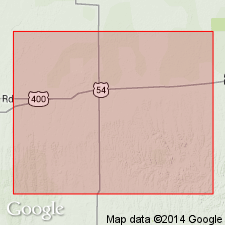
- Usage in publication:
-
- Corral sandstone
- Modifications:
-
- Original reference
- Dominant lithology:
-
- Sandstone
- AAPG geologic province:
-
- Anadarko basin
Cragin, F.W., 1895, A study of the Belvidere beds: American Geologist, v. 16, p. 357-385.
Summary:
Pg. 361, 366. Corral sandstone. Sandstone, 30 to 50 feet thick; lower part white; upper part often beautifully vareigated with bright reds mingled with yellow, purple, and brown. Basal part of Cheyenne sandstone. Overlain by Elk Creek beds (upper part of Cheyenne). Age is Early Cretaceous (Comanche).
[Named for the Natural corral, a short box canyon on Lanphier claim, in southeast corner of Kiowa Co., central southern KS, long known under that name by the settlers.]
Source: US geologic names lexicon (USGS Bull. 896, p. 524-525).

- Usage in publication:
-
- Corral sandstone†
- Modifications:
-
- Abandoned
- AAPG geologic province:
-
- Anadarko basin
Summary:
†Corral sandstone. This name was discarded by the USGS in 1921, the bed being simply a local facies of Cheyenne sandstone and without stratigraphic value; and the name seems to have been discarded by the Kansas Geol. Survey. (See last entry under Cheyenne sandstone.)
Source: US geologic names lexicon (USGS Bull. 896, p. 524-525).
For more information, please contact Nancy Stamm, Geologic Names Committee Secretary.
Asterisk (*) indicates published by U.S. Geological Survey authors.
"No current usage" (†) implies that a name has been abandoned or has fallen into disuse. Former usage and, if known, replacement name given in parentheses ( ).
Slash (/) indicates name conflicts with nomenclatural guidelines (CSN, 1933; ACSN, 1961, 1970; NACSN, 1983, 2005, 2021). May be explained within brackets ([ ]).

